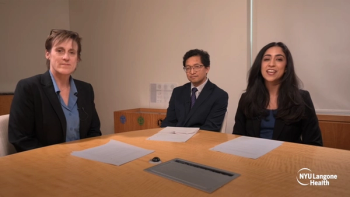
- Ophthalmology Times: June 15, 2021
- Volume 46
- Issue 10
Cataract surgeons on OR waste: Less is often more
Much of today’s surgical refuse is due to the single use of virtually everything.
Reviewed by David F. Chang, MD
A recent survey1 of
The survey was developed by the Ophthalmic Instrument Cleaning and Sterilization Task Force, which has representatives from the American Society of Cataract and Refractive Surgery, the American Academy of Ophthalmology (AAO), the Outpatient Ophthalmic Surgery Society, and the Canadian Ophthalmological Society.
The survey was disseminated to the members of all 4 societies.
Some impetus for the survey came from 2 published studies from the Aravind Hospital System in India.
Related:
The first report in 20172 found that their carbon footprint for phacoemulsification was one-twentieth of that in the United States and United Kingdom, largely because they reuse as many surgical supplies and drugs as possible.
A second study in 20193 found that despite such widespread reuse, the rate of endophthalmitis in the Aravind system was 0.01%—lower than that in the United States with the AAO IRIS registry rate of 0.04%.
“The results suggested that much of our surgical waste due to single use of everything is excessive and of unproven benefit for preventing endophthalmitis,” said David F. Chang, MD, clinical professor of ophthalmology, University of California, San Francisco, who coauthored the survey report with Cassandra Thiel, PhD, assistant professor, New York University School of Medicine.
What generates waste?
The respondents felt that the major factors accounting for OR waste were wasteful packaging of single-use items (71%), hospital/regulatory policies (74% and 82%, respectively) that limit surgeon discretion in reusing supplies, manufacturer mandates in instructions for use (IFU) for single-use products to limit liability (70%), and manufacturers driving the market toward more profitable single-use products (77%).
Surgeon or patient preference for single-use products was felt to be a driver by only 26% and 7%, respectively.
Related:
Support of reuse of devices and supplies
The surgeons strongly/somewhat agreed that manufacturers of devices and supplies should use recycled content in packaging of medical supplies (90%) and that they should consider the environmental/carbon footprint in product design (92%).
“However,” Chang said, “the real impact would be to offer more reusable instruments and supplies as options (94%) and allow surgeons greater discretion within their IFUs for reusing supplies (93%).”
Other areas with which surgeons strongly/somewhat agreed were more surgical discretion in the reuse of supplies by regulatory bodies (95%) and advocacy by medical societies to reduce the carbon footprint in ORs (87%).
Regarding the use of topical pharmaceuticals and intraocular pharmaceuticals, 98% and 95%, respectively, would consider using them in multiple patients; there was also strong agreement for reusing compounded pharmaceuticals (86%). Most surgeons are or would consider sending pharmaceuticals home with patients from the OR (93%).
Related:
Surgeons were very willing to reuse phaco tips (92%), phaco tubing and irrigation bottles (77%), cystotomes (72%), single-use cannulas and metal blades (74%), iris retractors (72%), and the unused halves of sutures (59%).
During cataract surgeries, 91% are or would consider using short-cycle sterilization, and 56% would consider simultaneous sequential bilateral cataract surgery, although 34% would not be willing to do so.
Among other conservation proposals, eliminating the full-body drape was supported by 95%, not having the patient put on a hospital gown was supported by 90%, and using the same surgical mask all day by the OR staff by 95%.
Two-thirds of respondents were open to not changing surgical gowns between every case, but 77% would not be willing to reuse surgical gloves.
Related:
Endophthalmitis (48%) and toxic anterior segment syndrome (43%) risks and malpractice liability (51%) were factors that decreased willingness to use supplies and medications on multiple patients.
Factors potentially driving single-use instruments included reduced staff processing requirements (45%) and improved OR efficiency (37%).
“However, the main factors driving manufacturers to promote single-use instruments were felt to be increasing profit (62%), reducing liability (66%), and an easier regulatory approval pathway (65%),” Chang said.
According to Chang, the findings showed that more than 90% of surgeons are concerned about global warming, excessive OR trash, the need for more reusable and multiuse options, strong preference for reusable over disposable instruments, discretion from regulatory agents and manufacturers in reusing materials, and greater manufacturer consideration of carbon footprint.
--
David F. Chang, MD
e:[email protected]
This article is adapted from Chang’s presentation at the American Academy of Ophthalmology 2020 virtual annual meeting. He has no financial interest in this subject matter.
--
References
1. Chang DF, Thiel CL; Ophthalmic Instrument Cleaning and Sterilization Task Force. Survey of cataract surgeons’ and nurses’ attitudes toward operating room waste. JuCataract Refract Surg. 2020;46(7):933-940. doi:10.1097/j.jcrs.0000000000000267
2. Thiel CL, Schehlein E, Ravilla T, et al. Cataract surgery and environmental sustainability: waste and lifecycle assessment of phacoemulsification at a private healthcare facility. J Cataract Refract Surg. 2017;43(11):1391-1398. doi:10.1016/j.jcrs.2017.08.017
3. Haripriya A, Chang DF, Ravindran R. Endophthalmitis reduction with intracameral moxifloxacin in eyes with and without surgical complications: results from 2 million consecutive cataract surgeries. J Cataract Refract Surg. 2019;45(9):1226-1233. doi:10.1016/j.jcrs.2019.04.018
Articles in this issue
over 4 years ago
VA, visual function are going the way of ocular inflammationover 4 years ago
The 2 faces of glaucomaover 4 years ago
Optic neuritis: Differentiating MS from neuromyelitis opticaover 4 years ago
Elamipretide: a mitochondrial protectorover 4 years ago
Maximizing CXL effectivenessover 4 years ago
App helps patients with cataracts have smoother surgery processover 4 years ago
An eye toward plateau iris and its implicationsover 4 years ago
Natural language processing pairs with big data curationNewsletter
Don’t miss out—get Ophthalmology Times updates on the latest clinical advancements and expert interviews, straight to your inbox.













































